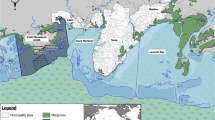Abstract
This study compared the health of flatfish inhabiting two areas in Placentia Bay, Newfoundland, contaminated either with polycyclic aromatic hydrocarbons (PAHs) or polychlorinated biphenyls (PCBs) with samples from reference sites. Initially, four species of flatfish, including American plaice (Hippoglossoides platessoides), yellowtail flounder (Limanda ferruginea), gray sole (Glyptocephalus cynoglossus), and winter flounder (Pleuronectes americanus), were sampled only for external lesions from commercial catches at three offshore sites. Others, captured by scuba divers at inshore sites, were autopsied to compare external lesions, condition (K) factor, hepatosomatic index (HSI), hemoglobin and lymphocyte levels, histological changes in the liver and spleen, and two parasites, metacercariae of Cryptocotyle lingua in the skin and a digenetic trematode, Steringophorus furciger, in the digestive tract. A higher prevalence of lesions occurred in the four species of flatfish caught offshore by commercial fisherman near the oil terminal and the PCB-contaminated dockyard than at a reference site. Lesions were also more prevalent in three species of flatfish captured by scuba divers inshore near the oil terminal and were associated with significantly lower K factor and lymphocyte levels but elevated HSI values and histopathological changes in the liver and spleen than in reference samples. Winter flounder sampled at two locations near the PCB-contaminated dockyard and a PAH-polluted small boat wharf also exhibited more external lesions, liver discoloration, and lower K factor, hemoglobin, and lymphocyte but higher HSI values and hepatic and splenic hemosiderosis than in reference fish. Prevalence of C. lingua in the skin was significantly greater but S. furciger in the digestive tract lower in samples taken from the aforementioned contaminated sites than from the reference locations. These results, based on several bioindicators, suggest that the health of bottom-dwelling flatfish at three sites of this embayment was impaired by chronic exposure to sediment contaminated with PAHs or PCBs.
Similar content being viewed by others
Author information
Authors and Affiliations
Additional information
Received: 9 April 2002/Accepted: 11 November 2002
Rights and permissions
About this article
Cite this article
Khan, R. Health of Flatfish from Localities in Placentia Bay, Newfoundland, Contaminated with Petroleum and PCBs. Arch. Environ. Contam. Toxicol. 44, 0485–0492 (2003). https://doi.org/10.1007/s00244-002-2063-9
Issue Date:
DOI: https://doi.org/10.1007/s00244-002-2063-9




